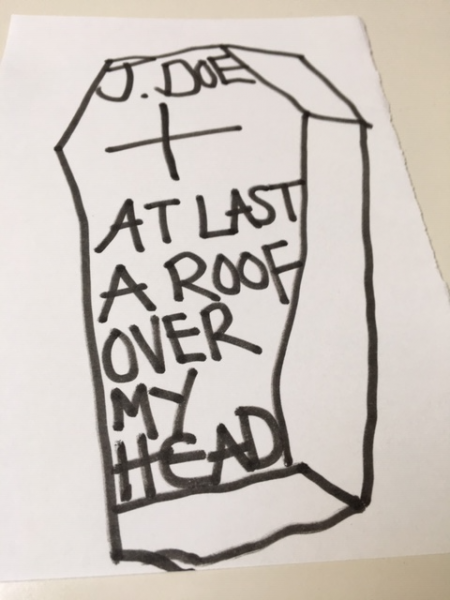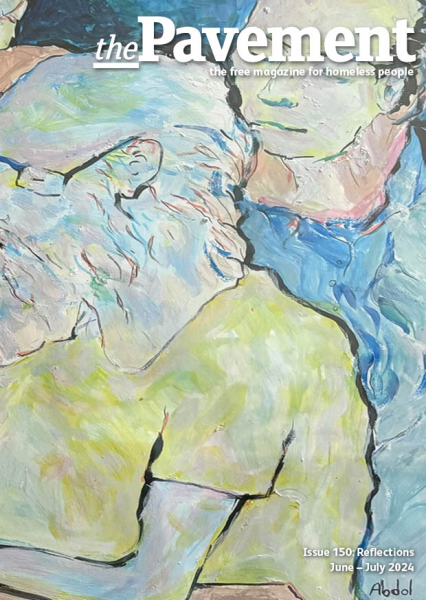
Established 2005 Registered Charity No. 1110656
Scottish Charity Register No. SC043760
DONATE
RECENT TWEETS
 Sadly on a podcast by our Glasgow News Group a man told us: “I’ve been to 15 funerals in the last 18 years. They were all under 40.” © Jean Hindry
Sadly on a podcast by our Glasgow News Group a man told us: “I’ve been to 15 funerals in the last 18 years. They were all under 40.” © Jean Hindry
A rough sleepers’ guide about
dying homeless, by Alastair
Murray who has helped
run the annual Service of
Commemoration at St-Martin-in-the-Fields since 2003
Q: What happens if someone dies homeless on the street? The death needs to be reported as soon as possible to the emergency services (tel: 999), ideally by the person who found the body. The police will normally be the first on the scene alongside paramedics or an ambulance. A cordon will be placed around the body to give dignity and privacy, and to enable police to investigate the scene for any evidence which might help identify the cause of death. The death will also be reported to the local Coroner, and a post mortem is usually required. Local homeless services such as day centres, outreach workers, church and community services should also be informed.
Q: What about the person's family or next of kin? People who have been seen sleeping on the street by outreach workers will usually have some information recorded with local services. In London this would be held on the Combined Homelessness and Information Network (CHAIN) database which records personal details such as name, nicknames, date of birth and contacts with services. This information is not always accurate or complete, but it could be the best available, especially for the difficult task of informing the next of kin. If the person is not known to local outreach workers or other services, perhaps by their own choice, this can make identification and any follow up action more problematic. However, people who've been homeless for any length of time will be known at least to their friends on the street and in the community. It is also worth noting that relationship breakdown is a common feature of homeless people's lives. Respectfully negotiating the wishes and demands of all parties will require considerable tact and sensitivity.
Q: What happens afterwards? Homeless Link recommends that the death of a homeless person should always initiate a review. Were opportunities missed to help this person to move off the streets and into safety? What are the lessons which need to be learned to prevent something similar happening again? In the case of serious shortcomings in services, which might have prevented the death, this might take the form of a Safeguarding Adult Review.
Q: Funeral, Commemoration, and
recording deaths
In most cases friends of the person
who has died will join with staff of
local homeless services and clergy
to organise a funeral. Churches will
always be sympathetic to a request
to hold a funeral, especially if the
person who died was known to the
church, perhaps having stayed in
the night shelter or using the church
community drop-in.
In Remembrance Week each
year a service is held at St Martinin-the-Fields, commemorating the
lives of all who have died homeless
in the previous year in London. The
most poignant part of the service is
always the reading of the long list
of names of those who have died,
including those who have died on the
streets, as well as all the names from
the hostels, day centres, outreach
teams, health services (especially
Great Chapel Street), and church and
community shelters.
The Bureau of Investigative
Journalism (TBIJ), the Museum of
Homelessness, Streets Kitchen, the
Pavement and Housing Justice,
among others, have sought to draw
attention to this issue. The year
long TBIJ investigation, published
in 2018 led Channel 4 News
broadcasting a series of reports into
homeless deaths. It also prompted
the Office of National Statistics to
start recording homeless deaths.
The Museum of Homelessness now
holds the Dying Homeless Project,
to record and memorialise each
homeless death, including the cause,
so that people are not forgotten, and
to encourage and provoke change in
the system.
- Homeless Link: homeless.org.uk
- TBIJ Dying Homeless reports. www.thebureauinvestigates.com
- Museum of Homelessness museumofhomelessness.org
June – July 2024 : Reflections
CONTENTS
BACK ISSUES
- Issue 150 : June – July 2024 : Reflections
- Issue 149 : April – May 2024 : Compassion
- Issue 148 : February – March 2024 : The little things
- Issue 147 : December 2023 – January 2024 : Next steps
- Issue 146 : October 2023 – November 2023 : Kind acts
- Issue 145 : August 2023 – September 2023 : Mental health
- Issue 144 : June 2023 – July 2023 : Community
- Issue 143 : April 2023 - May 2023 : Hope springs
- Issue 142 : February 2023 - March 2023 : New Beginnings
- Issue 141 : December 2022 - January 2023 : Winter Homeless
- Issue 140 : October - November 2022 : Resolve
- Issue 139 : August - September 2022 : Creativity
- Issue 138 : June - July 2022 : Practical advice
- Issue 137 : April - May 2022 : Connection
- Issue 136 : February - March 2022 : RESPECT
- Issue 135 : Dec 2021 - Jan 2022 : OPPORTUNITY
- Issue 134 : September-October 2021 : Losses and gains
- Issue 133 : July-August 2021 : Know Your Rights
- Issue 132 : May-June 2021 : Access to Healthcare
- Issue 131 : Mar-Apr 2021 : SOLUTIONS
- Issue 130 : Jan-Feb 2021 : CHANGE
- Issue 129 : Nov-Dec 2020 : UNBELIEVABLE
- Issue 128 : Sep-Oct 2020 : COPING
- Issue 127 : Jul-Aug 2020 : HOPE
- Issue 126 : Health & Wellbeing in a Crisis
- Issue 125 : Mar-Apr 2020 : MOVING ON
- Issue 124 : Jan-Feb 2020 : STREET FOOD
- Issue 123 : Nov-Dec 2019 : HOSTELS
- Issue 122 : Sep 2019 : DEATH ON THE STREETS
- Issue 121 : July-Aug 2019 : INVISIBLE YOUTH
- Issue 120 : May-June 2019 : RECOVERY
- Issue 119 : Mar-Apr 2019 : WELLBEING
- Issue 118 : Jan-Feb 2019 : WORKING HOMELESS
- Issue 117 : Nov-Dec 2018 : HER STORY
- Issue 116 : Sept-Oct 2018 : TOILET TALK
- Issue 115 : July-Aug 2018 : HIDDEN HOMELESS
- Issue 114 : May-Jun 2018 : REBUILD YOUR LIFE
- Issue 113 : Mar–Apr 2018 : REMEMBRANCE
- Issue 112 : Jan-Feb 2018
- Issue 111 : Nov-Dec 2017
- Issue 110 : Sept-Oct 2017
- Issue 109 : July-Aug 2017
- Issue 108 : Apr-May 2017
- Issue 107 : Feb-Mar 2017
- Issue 106 : Dec 2016 - Jan 2017
- Issue 105 : Oct-Nov 2016
- Issue 104 : Aug-Sept 2016
- Issue 103 : May-June 2016
- Issue 102 : Mar-Apr 2016
- Issue 101 : Jan-Feb 2016
- Issue 100 : Nov-Dec 2015
- Issue 99 : Sept-Oct 2015
- Issue 98 : July-Aug 2015
- Issue 97 : May-Jun 2015
- Issue 96 : April 2015 [Mini Issue]
- Issue 95 : March 2015
- Issue 94 : February 2015
- Issue 93 : December 2014
- Issue 92 : November 2014
- Issue 91 : October 2014
- Issue 90 : September 2014
- Issue 89 : July 2014
- Issue 88 : June 2014
- Issue 87 : May 2014
- Issue 86 : April 2014
- Issue 85 : March 2014
- Issue 84 : February 2014
- Issue 83 : December 2013
- Issue 82 : November 2013
- Issue 81 : October 2013
- Issue 80 : September 2013
- Issue 79 : June 2013
- Issue 78 : 78
- Issue 77 : 77
- Issue 76 : 76
- Issue 75 : 75
- Issue 74 : 74
- Issue 73 : 73
- Issue 72 : 72
- Issue 71 : 71
- Issue 70 : 70
- Issue 69 : 69
- Issue 68 : 68
- Issue 67 : 67
- Issue 66 : 66
- Issue 65 : 65
- Issue 64 : 64
- Issue 63 : 63
- Issue 62 : 62
- Issue 61 : 61
- Issue 60 : 60
- Issue 59 : 59
- Issue 58 : 58
- Issue 57 : 57
- Issue 56 : 56
- Issue 56 : 56
- Issue 55 : 55
- Issue 54 : 54
- Issue 53 : 53
- Issue 52 : 52
- Issue 51 : 51
- Issue 50 : 50
- Issue 49 : 49
- Issue 48 : 48
- Issue 47 : 47
- Issue 46 : 46
- Issue 45 : 45
- Issue 44 : 44
- Issue 43 : 43
- Issue 42 : 42
- Issue 5 : 05
- Issue 4 : 04
- Issue 2 : 02
- Issue 1 : 01
- Issue 41 : 41
- Issue 40 : 40
- Issue 39 : 39
- Issue 38 : 38
- Issue 37 : 37
- Issue 36 : 36
- Issue 35 : 35
- Issue 34 : 34
- Issue 33 : 33
- Issue 10 : 10
- Issue 9 : 09
- Issue 6 : 06
- Issue 3 : 03
- Issue 32 : 32
- Issue 31 : 31
- Issue 30 : 30
- Issue 29 : 29
- Issue 11 : 11
- Issue 12 : 12
- Issue 13 : 13
- Issue 14 : 14
- Issue 15 : 15
- Issue 16 : 16
- Issue 17 : 17
- Issue 18 : 18
- Issue 19 : 19
- Issue 20 : 20
- Issue 21 : 21
- Issue 22 : 22
- Issue 23 : 23
- Issue 24 : 24
- Issue 25 : 25
- Issue 8 : 08
- Issue 7 : 07
- Issue 26 : 26
- Issue 27 : 27
- Issue 28 : 28
- Issue 1 : 01
